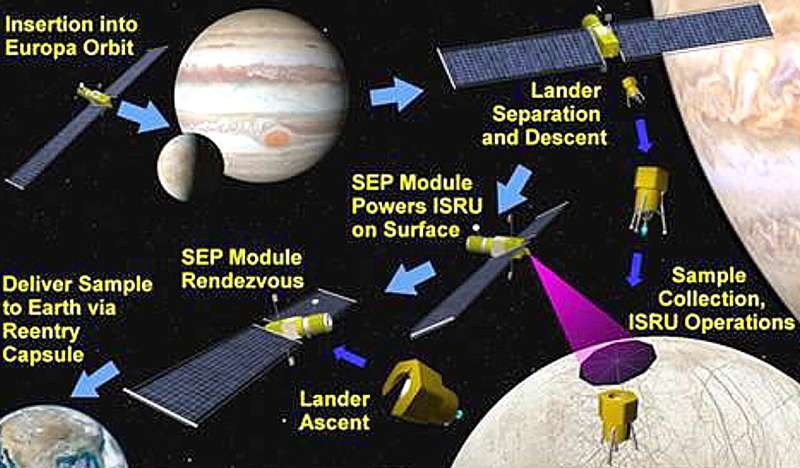This article has been reviewed according to Science X's editorial process and policies. Editors have highlighted the following attributes while ensuring the content's credibility:
fact-checked
trusted source
proofread
A European lander could return an ice core for a fraction of the cost of Europa Clipper

Cost is a major driving factor in the development of space exploration missions. Any new technology or trick that could lower the cost of a mission makes it much more appealing for mission planners. Therefore, much of NASA's research goes into those technologies that enable cheaper missions.
For example, a few years ago, NASA's Institute for Advanced Concepts (NIAC) supported a project by Michael VanWoerkom of ExoTerra Resource to develop a lander mission that could support a sample return from Europa. Let's examine what made that mission different from other Europa mission architectures.
The Nano Icy Moons Propellant Harvester (NIMPH) mission relies on three main advancements for one significant result: a 10x reduction in the overall mission cost. That reduced cost comes mainly from a single fact—the mission's weight has dropped below the threshold where it can be launched by an Atlas V rather than the SLS, as similar missions would require.
The mission cost estimated for an SLS-launched Europa lander was about $5 billion, making it prohibitively expensive for NASA or any other agency without significant sacrifices to other missions. ExoTerra estimates that, by using several weight-reducing technologies, they could bring the mission price tag down to $500 million—a much more reasonable sum to garner support from one of the government space programs.
Three different technologies would enable this weight and cost to drop. First would be the solar electric propulsion (SEP) system initially designed for use on DART. The second would be a micro in-situ resource utilization (µISRU) system, and the third would be a power-beaming system between the lander and an orbiter.
Let's first look at the overall mission architecture to understand how each contributes. In NIMPH, a combined orbiter lander will use an Atlas V rocket to get into Earth orbit. Then, a solar electric propulsion system (SEP) was initially designed for use on the DART asteroid redirect test.
Although it was not used during the DART mission, the NEXT ion thruster was part of the spacecraft that launched, and, despite suffering from some technical challenges, it could have allowed the spacecraft to reach its destination. A similar, lightweight SEP system could get NIMPH to the Jupiter system, but it could also get the sample back to Earth after the lander collected it.
Just how the lander can get that sample back off the icy moon is the focus of the next major technological step—the µISRU system. NIMPH's architecture would require using the local ice as a propellant. A lander would literally sublimate the ice under its feet, suck up the resultant water vapor, electrolyze it to split it into oxygen and hydrogen, and then liquefy it to store it for use in getting a 1 kg ice core sample back into orbit.
To do all of this requires power, though, and a lander with a radioisotope thermal generator or similar commonly used power generation system would be prohibitively heavy. So, why not utilize the massive solar array required for the SEP system and beam some of that power down to the lander? That is the concept behind the power beaming system, estimated to produce around 2 kW of power in the Jovian system, about 1.8 kW of which could be beamed directly to a lander.
After the core has been collected and safely launched back into space using a specially designed LOx-LH2 engine that uses the water collected by the µISRU system, the lander meets up with the orbiter. The SEP system kicks back on and delivers the lander back to Earth orbit, where it once again detaches and rides back to Earth's surface inside a standard reentry module.
There are some nuances to this entire mission architecture. For example, the SEP system wouldn't work at full capacity in the Jovian system, so a much smaller LOx / Methane propulsion system is needed to maneuver the orbiter into position. Additionally, the lander would likely have to leave its legs embedded in the Europan ice, as the sublimation process it uses to collect fuel would likely embed them in place.
Plenty of development work on all these systems must be completed before any such mission is ready for launch. And most likely, some of the need for the scientific understanding would be met by the Europa Clipper mission set to launch later this year for $4.25 billion—not far off the 10x expense that was the original impetus for the more capable NIMPH mission design.
And while NIMPH did receive a Phase II NIAC grant, it hasn't been selected for further development as far as we have found. So, as of now, this novel combination of mass-saving technologies will not be delivering an icy Europan sample any time soon—but maybe someday it will.
Provided by Universe Today




















